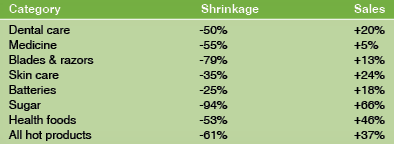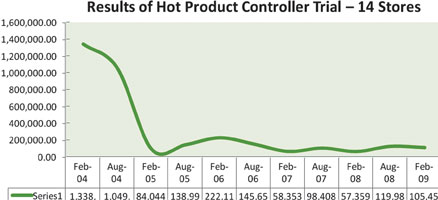
The South African economy seems to have the resilience to weather the global slow-down affected by rising food and fuel prices. However, there are significant weaknesses that continue to hinder economic growth, including unemployment, HIV/Aids, and crime.
Rates of unemployment are very high, currently reaching levels above 20%. In addition, South Africa has the largest recorded HIV epidemic in the world with 5,7 million people living with the disease. On top of this, South Africa holds the unenviable title of having one of the highest murder rates in the world, with violent crime continuing to be a major problem to all communities. Although overall levels of crime have gradually decreased, the blight of crime still remains a real challenge. Of the over two million crimes reported across the country to the police in the years 2007–2008, 52% were theft related to commercial and property crime. The official statistics also showed an increase in burglaries of businesses of 8% and an increase in shoplifting by 2%.
It is now 15 years into democracy for South Africa and more than 20 years after the end of apartheid and due to favourable economic conditions and Black Economic Empowerment (BEE), the black middle class has continued to grow at an estimated 30% per annum. The difference in buying power between the white population and the black middle class has reduced by 50%, and this growth has positively affected the development of the retailing industry in South Africa.

The effect on shrinkage
Within the retail sector, shrinkage is a major issue with internal theft considered one of the biggest problems facing retailers in South Africa. Dealing with this particular problem is not easy, and it is often argued that a legislative straightjacket makes it very difficult for retailers to gain convictions for errant staff. It usually is easier to simply sack them than take them through the legal process.
Of course, not all staff are dishonest, but those who choose to steal often keep the honest staff hostage to their dirty deeds, citing the inequalities of the past by justifying their acts of theft as a redistribution of wealth. This attitude rationalises that taking money away from businesses is not considered theft, but part of the ongoing struggle.
As a result of this, retail systems and processes along the supply chain have been developed that are considered to be relatively robust, with many controls in place to try to reduce the opportunities for theft. However, this requires good systems of management and adherence to store policies, which is an ongoing challenge to South African retailers. A large general merchandise retailer approached Procter & Gamble to discuss the high loss levels they were experiencing on blades and razors in a particular region of the country.
It was agreed that a collaborative approach was needed to identify root causes and develop a solution that would not only improve the processes operating within the supply chain and the store, but also reduce shrinkage and increase on-shelf availability. Up until this point, the reaction to stock loss at store level had been to merchandise defensively those shrinkage-sensitive products identified after the stock take results had been analysed.
This usually meant taking those hot products off open sale and placing them either behind the cigarette or service counter, or keeping them in anti-theft display fixtures at the checkout. With the razor blade range of products, this not only splits the category by putting blades in one place, shaving accessories in another, but also often frustrates the shopper as there is inevitably a delay in obtaining these goods, such as second queuing at the service desk.
Developing a solution
It was considered essential to find a solution that not only reduced the levels of shrinkage on high-risk products, but also improved the supply-chain process from receiving to shelf to ensure that products were always available for sale. From a manufacturer’s point of view, a solution was required to improve product availability, reduce out-of-stocks (OOS), improve category value, and improve shopper satisfaction at the first moment of truth (FMOT) – the shelf. A winning approach was needed to meet expectations from both the retailers’ and manufacturers’ points of view, but ultimately working from the shelf backwards to ensure that the shoppers’ needs were met.
This was not just about Procter & Gamble or the retailer, it was about developing a best practice for all hot-product manufacturers and finding a solution that could be applied in all retail operations. The benefits are mutual, the goals are the same and there was no reason why barriers could not be removed to tackle a problem that seemed to transcend company boundaries. Collaboration was not only required between the retailer and the manufacturer, but also between Procter & Gamble and other manufacturers. This solution also had to give the store managers the confidence to move hot products away from defensive merchandising and place them back on open sale.
It was quickly agreed that strong controls were required to secure the handling of hot products at the receiving area, to ensure these products were kept separate and were well secured in the storeroom. Shelves had to be replenished without using outside contractors or staff members – fewer hands, less shrink. It was also agreed that the project should be highly focused on only those products that were suffering from the highest levels of loss and the stores with the highest rates of shrinkage; the simple and pragmatic 80/20 principle (20% of products cause 80% of shrink) was used.
It was finally decided to focus upon 54 super-hot products and 14 high-shrinkage stores within the retailer’s estate. Through the auspices of Economic Consumer Response (ECR) South Africa, a shrinkage committee was set up to discuss and develop this project with other manufacturers and the retailer. After much discussion, it was decided to put a store champion in each of the hot stores who would have complete responsibility for overseeing the handling of all the hot products included in the trial. The store champion would become a product guardian whose sole responsibility was to reduce the opportunities for both malicious (theft) and non-malicious (administrative errors) shrinkage to occur from the moment goods arrived at the store until a customer selected it for purchase at the shelf. It was agreed that the cost of this hot product controller (HPC) would be shared between the participating manufacturers and the retailer.

Hot product controllers
As detailed in Figure 1, the role of the HPC was to focus on five key areas:
* Secure delivery of the goods to the store.
* Fast tracking of products once they arrived to a secure place.
* Secure storage of these products within a locked security cage.
* Daily counts to monitor on shelf availability and levels of shrinkage.
* Shelf replenishment to keep levels of on shelf availability high and consistent.
Secure delivery. The receiving area is often a very busy part of a retail store and this is one area in particular that needs strict compliance to systems and strong controls. The aim was to reduce the opportunities for suppliers to short deliver goods, prevent collusion between truck drivers and receiving staff, and ensure that all goods were correctly captured according to the delivery invoice. The hot product controller’s primary responsibility at this stage was to double check all hot product deliveries with the receiving clerk including: check quantities, spot-check containers (dummy stacking), check product description, check pack size, and capture delivery amounts correctly.
Fast track. The receiving area is a high-traffic area and there are ample opportunities for theft and damages to occur as staff and delivery personnel move throughout the area. To ensure that stock was not left unattended, the HPC had to ensure immediate transfer of all hot products to a secure storage facility as soon as the receiving clerk and the controller had verified the goods arriving. There was to be no unavoidable delay.
Secure storage. A secure storage facility will ensure that unauthorised access to hot products is limited, which significantly reduces the number of opportunities for theft during and after store opening hours. A padlock and key is for honest people, and a determined thief will often find a way to gain access. The HPC had to ensure that his cage was secured and that the keys could not be duplicated. This process meant that there was only one key holder to this locker facility, one person responsible and therefore one person accountable.
Daily counts. Daily stock counts at both the floor display and secure locker allowed the HPC to measure and adapt on a daily basis and not wait the usual six months or more between stocktakes before they had actionable data. Opening and closing counts with daily sales ensured that the HPC could identify theft after hours, shoplifting activity, short deliveries, or theft from the secure locker. This regime of rigorous counting also had a knock-on effect upon attitudes amongst other store staff, with increased awareness noticeable throughout the store, significantly raising the risk of being caught, and so deterring both internal and external theft. Daily counts also improved inventory control and the ordering process, preventing trade loading, reducing out of stocks, whilst also identifying both internal and external theft.
Shelf replenishment. The HPCs were required to fill shelves at the same rate as sales, reducing stock quantities during slow trading days (Mondays and Tuesdays), increasing quantities slightly mid-week, and fully stocking the shelves over the busy weekend period. Replenishing shelves on a little but often basis can certainly help to discourage professional thieves as their overall haul of stolen goods is limited, but at the same time it does not frustrate honest shoppers who still have access to goods.
Program implementation
The HPC function was outsourced to an international security company who ensured that all stores would have full coverage from Monday to Sunday; a 48-hour week with relief controllers deployed to cover gaps in store hours. Each HPC was provided with a detailed training programme to ensure they were fully prepared for the position they were to occupy in the stores. The project ran for a six-month trial period. While participation was voluntary on the part of manufacturers, the benefits from a manufacturer’s perspective were potentially substantial, tackling the problem of out of stocks and keeping products on open sale.
Results
The results of the trial were good, giving a return on investment of 132%. As can be seen in the table, shrinkage reduced on all hot product categories by 61% and sales improved by 37%. The categories of sugar and blades and razors achieved the greatest reductions in shrinkage, 94% and 79% respectively. During the period, the cost of shrinkage on Procter & Gamble products in these stores dropped from $83 000 to $2500, equating to a staggering 97% reduction. As a result of this project, the retailer extended the use of HPCs to other regions and in particular tried out the concept in one of their larger hypermarkets, but this time only working on Procter & Gamble hot products. The impact was again dramatic and highly cost effective. After six months the cost of shrinkage was reduced from $23 000 to $1500, a 94% reduction. Although no changes were made to the display location of Procter & Gamble products, a sales uplift of 44% was recorded over this period. As a result of this trial, the retailer, perhaps not surprisingly, has now placed HPCs in all of their hypermarkets throughout the country.

A proven shrinkage solution. Retail operations in South Africa have to endure a number of unusual pressures that can be attributed to high crime and other socio-economic factors that would not necessarily be experienced in other countries.
The supply chain from distribution to shelf is often tried, tested, and, in most cases, beaten by organised crime, internal theft, and to some extent opportunistic shoplifting. The hot product controller solution has proven to have a dramatic effect on reducing shrinkage and increasing sales and is a solution that could be adopted by other retailers. If it can work in South Africa, it can work anywhere!
We often have a knee-jerk reaction to shrinkage – solutions generally focus on one small part of the supply chain; they are often technology based; they frequently add complexity to the business; and by and large are discarded after six months. On the other hand, the hot product controller solution is still used today. It has proven to be sustainable and is now being adopted by other retailers in other regions. It is a solution that puts the focus back on process improvement and compliance throughout the supply chain. Above all, it reduces the opportunities for both non-malicious and malicious shrinkage to occur as there is significantly more transparency and accountability.
Problems can be more quickly identified, opportunities for theft become much more risky, and errors can be quickly identified and corrected. This project also showed the strong link between shrinkage and out of stocks and how bad shrinkage can have a major impact upon sales.
For more information contact Lodge Sibumbene, +27 (0)82 786 2606, [email protected]
| Tel: | +27 11 791 1502 |
| Email: | [email protected] |
| www: | www.lodgesecurity.co.za |
| Articles: | More information and articles about Lodge Security Services |

© Technews Publishing (Pty) Ltd. | All Rights Reserved.